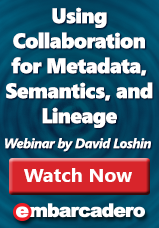This is the last in a series of six posts on metadata collaboration from David Loshin. Read the previous post in the series.
In my earlier blog entries, we have looked at the need for common semantics for enterprise information concepts and the need to engage the business users as part of a larger community to steward the standardization of meta-concepts. Having a process for engagement is the first step, but without providing a means and a platform for continuous interaction and commitment, there is a risk of the metadata becoming stale (at best) or obsolete (at worst).

Semantic metadata can become the language through which the business users and data practitioners communicate, and this communication requires a medium through which the different players interact. A typical metadata “repository” is just a repository, and while it can be a good tool for storing metadata, in many cases it is difficult for the stored metadata to be accessed and made actionable.
We need tools that are not just limited to storing the metadata but instead facilitate knowledge sharing and in the context of metadata and collaboration in its definition and use. A tool that enables the right kind of collaboration should provide some of these key capabilities:
- Define business terms.
- Define conceptual domains and reference data sets.
- Define data element concepts.
- Capture and review data element structural metadata.
- Allow users to subscribe to indicate interest in a metadata concept.
- Provide automatic notifications to subscribed individuals when some aspect of a metadata item has been updated.
- Allow users to search business terms, data element concepts, and definitions for key words.
- Map data elements to their use within data artifacts such as databases or reports.
- Map data elements to their use within business processes and applications.
- Present a broad perspective on data lineage across the enterprise.
- Capture discussions and interactions about definitions.
- Allow for contextual business term definitions that may differ depending on use.
- Provide a means for reviewing definitions as part of a harmonization process.
In other words, collaborative management for semantic metadata implies a need for tools and technology that not only capture information about business terms, data elements, definitions, structure, lineage, and value domains and other content criteria, but also provide a means for interaction among the self-identified parties with a stake in maintaining consistency and precision of definition and use.
By enabling an environment that allows for comments about definitions, interactive debate, and processes for collaboration and resolution of identified discrepancies, we can migrate away from the dreaded metadata black hole. Collaborative methods breathe life into the metadata management processes, and through awareness and information-sharing, will elevate metadata into an actionable asset that influences behaviors that lead to increased semantic consistency, reduced confusion, and streamlined and clear communication.
________________________________________________________________________________
Want to see more from David Loshin? Watch this on-demand webinar:
Using Collaboration for Metadata, Semantics, and Lineage
Want to learn more about ER/Studio? Try it for yourself free for 14 days!
About the author: David Loshin, president of Knowledge Integrity, Inc. (www.knowledge-integrity.com), is a recognized thought leader and expert consultant in the areas of analytics, big data, data governance, data quality, master data management, and business intelligence. Along with consulting on numerous data management projects over the past 15 years, David is also a prolific author regarding business intelligence best practices, with numerous books and papers on data management, including the second edition of “Business Intelligence – The Savvy Manager’s Guide”.
David Loshin, president of Knowledge Integrity, Inc. (www.knowledge-integrity.com), is a recognized thought leader and expert consultant in the areas of analytics, big data, data governance, data quality, master data management, and business intelligence. Along with consulting on numerous data management projects over the past 15 years, David is also a prolific author regarding business intelligence best practices, with numerous books and papers on data management, including the second edition of “Business Intelligence – The Savvy Manager’s Guide”.
 David Loshin, president of Knowledge Integrity, Inc. (www.knowledge-integrity.com), is a recognized thought leader and expert consultant in the areas of analytics, big data, data governance, data quality, master data management, and business intelligence. Along with consulting on numerous data management projects over the past 15 years, David is also a prolific author regarding business intelligence best practices, with numerous books and papers on data management, including the second edition of “Business Intelligence – The Savvy Manager’s Guide”.
David Loshin, president of Knowledge Integrity, Inc. (www.knowledge-integrity.com), is a recognized thought leader and expert consultant in the areas of analytics, big data, data governance, data quality, master data management, and business intelligence. Along with consulting on numerous data management projects over the past 15 years, David is also a prolific author regarding business intelligence best practices, with numerous books and papers on data management, including the second edition of “Business Intelligence – The Savvy Manager’s Guide”.